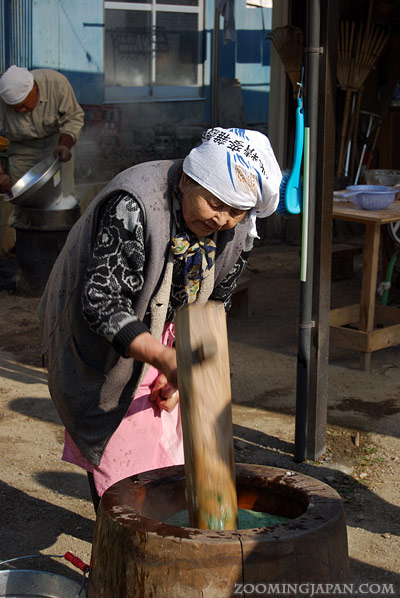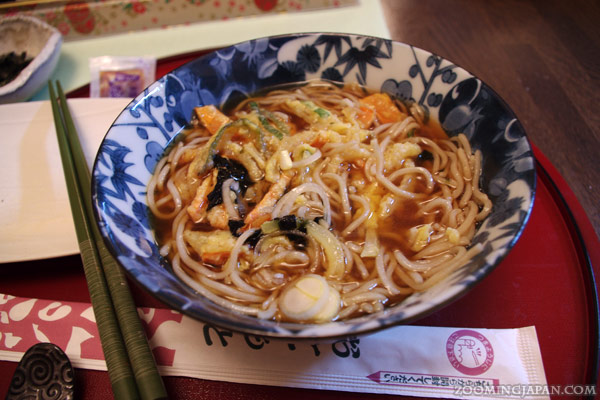Around this time of the year Japanese people are busy with various things. Christmas is not what keeps them busy, but the two most important days in Japan: Omisoka (Japanese New Year’s Eve) and Shogatsu (Japanese New Year’s Day).
1. End-of-the-year Preparation
Before the year comes to an end and those two days finally take place, there are a lot of things that have to be done.
Japanese people are supposed to write Nengajo (Japanese New Year’s Cards) to all their friends, co-workers, customers and so forth.
There are also Bonenkai parties (忘年会: parties to forget about the year) with friends and co-workers.
Many Japanese will send end-of-the-year gifts (お歳暮, oseibo).
Some families make their own rice cakes (餅つき, mochitsuki). Mochi plays an important role for the new year as many people will eat it on New Year’s Day (Zôni: a soup with rice cakes, vegetables and kamaboko) and it’s also used as New Year’s decoration (kagami mochi).

As cooking on January 1st (as well as going out, cleaning, even taking a bath) is considered to bring bad luck, Japanese people try to finish everything before the new year hits. Thus, some people become busy preparing the traditional ‘Osechi Ryori‘ (御節料理) that will be eaten on New Year’s Day, but nowadays most people just order it.
Cleaning everything thoroughly (大掃除, ôsouji) before the winter vacation starts is also very common. Not only at home, but also at work everything will be left in a perfect condition.
2. New Year’s Decoration:
After the cleaning people will put out their traditional New Year’s decoration such as “shime-kazari” (しめ飾り).

It is made of a sacred Shinto straw rope (注連縄, shimenawa) and other materials such as ferns and white ritual paper strips (紙垂, 四手, shide). Especially popular are bitter oranges (橙, daidai). They are considered to be a good omen as “dai-dai” can also be written with the kanji “代々” meaning from “generation to generation” and symbolizes the continuation of a family from generation to generation
Another traditional decoration is “kagami mochi” (鏡餅, lit.: mirror rice cake). Two rice cakes, the smaller on top of the larger one, and a daidai as a good omen are the usual parts of “kagami mochi”. The two mochi pieces represent the going and the coming years.
In some regions of Japan you can find a three-layered version of kagami mochi.
Nowadays most people place it in front of their household Shinto altar, but a long time ago it was placed in various locations within the house.
You can buy a more modern version of kagami mochi in the supermarket as soon as December comes. A very common one is with the zodiac of the coming year on top of it. I bought the one in the photo in late 2009 as 2010 was the year of the tiger. They also sell some with plastic oranges on top.
After the New Year’s celebration is over (usually on the 2nd Saturday or Sunday in January), the kagami mochi is broken and eaten in a traditional Shinto ritual “Kagami Biraki” (鏡開き, mirror opening).

Another common decoration you’ll find in front of the entrance of restaurants, shops or hotels is “Kadomatsu” (門松, lit. “gate pine”). Some people also put them up in front of their home’s entrance as well.
This is supposed to be the housing for the “Toshigami” (年神), a god that will visit for the New Year’s celebration. If you put the Kadomatsu up quite late in December, the gods can’t stay long enough – which is considered as bad omen.
Toshigami will bless farmers with a good harvest and bestow the ancestors’ blessing on everyone. Around January 15th the Kadomatsu is burned to release the deity again.
3. Celebrating New Year’s Eve (Omisoka):
After all these various preparations it’s finally time to celebrate the 31st of December which is called Omisoka (大晦日).
I was lucky enough to spent this time of the year with different Japanese families, so I won’t just tell you the facts, but also my personal experience!
Japanese people work a lot and don’t have much vacation, but most get time off for at least the time between December 29th and January 3rd.
Omisoka is traditionally spent together with the family, even more though the 1st of January.

A traditional food is “Toshikoshi Soba” (年越しそば, “year-passing buckwheat noodles”) that promises a long life when eaten on New Year’s Eve (Omisoka).
After or while eating most families just sit together and relax. Most of them are watching TV.
There’s a huge variety of special New Year’s Eve programs. The most popular TV program is without a doubt “Kôhaku” (紅白歌合戦, Kôhaku Uta Gassen) broadcasted by NHK.
It’s a music competition. Two teams (red: women, white: men – consisting of popular Japanese singers and bands) compete with each other. It’s not a very serious competition. In fact, I’m sure that most people don’t even care who wins, but it’s quite entertaining.
In 2011 young actress Maki Horikita and the popular boy band Arashi were hosting the show, attracting a lot of young viewers.
Besides that, there are a lot of other entertaining shows. Personally I watch the so-called “Johnny’s Countdown” that airs for the last few minutes in the old year, taking the viewers into the new year with a lot of popular Johnny idols.
4. Jumping into the New Year:
In my first year in Japan “celebrating the new year” was a really tough experience for me. I was sitting in front of the TV, noticing that midnight was getting closer, getting excited all by myself while the people around me slowly went to take a bath or already went to bed. ![]()
Most of us Westerners are used to having parties, having a great countdown and then fireworks to welcome the new year. It’s loud, it’s cheerful, it’s a big deal. In Japan, on the other hand, it’s quiet. It’s like … nothing has happened. You don’t even notice that a new year has started!
However, just before midnight Buddhist temple bells across Japan can be heard (除夜の鐘, joya no kane). The bell is struck 108 times to purify the people from their 108 earthly passions. It takes roughly one hour to strike the bell 108 times. Some temples let you strike the bell, but you should arrive early!
Some people visit a local Shinto shrine shortly after midnight. The first visit of a shrine in the new year is called Hatsumode (初詣). Traditionally sweet sake (甘酒, amazake) is passed out (free of charge!) to the crowds that gather to pray that night.
Some people even stay awake (or wake up very early) to see the first sunrise (初日) as this is supposed to guarantee good luck for the new year.
This is already part of “Shogatsu” (正月) – Japanese New Year’s Day.
良いお年を!
(yoi o-toshi o, “Have a good New Year!”)
良いお年を! ![]()
Have a good New Year! ![]()










We always look forward to getting together with the Japanese family on New Year’s Eve. We traditionally eat toshikoshi soba and visit a temple at midnight. We don’t do too much on New Year’s Day, just spend time together with the family. Nice to relax for a bit after a busy year.
I hope you had a nice Omisoka and New Year’s Day this year as well! :)
Oh I have not yet bought Kagami-mochi!! It’s the first time I’ve ever seen one with a tiger on it. I wonder if the animal represents Hanshin Tigers?! I believe that it is a special version of Kagami-mochi for Kansai. I have to clean up my house before 31.
Many thanks for reading my posts and your heart-warming comments this year. I really appreciate it, It’s getting colder and colder. Take care!! よいお年を!!
Looking forward to your new posts in 2013 (the world won’t end tomorrow perhaps).
No, it has nothing to do with Hanshin Tigers. *g* (At that time I didn’t even live in Kansai!)
They sold a lot of cute snake ones this year in all the supermarkets I went to. I also saw some of them outside while traveling!
It’s always the zodiac of the new year on top. I wish I bought the rabbit version back then. :/
Thanks! I hope you had a great start into the new year! ^___^
今年もよろしくね!♪
I found a nice web page like this.
I try to see this as many as possible.
Thank you.
Ein herzliches Hallo aus Amerika (Chicago, IL) verbunden mit dem Wunsch fuer Sie
“ein glueckliches und gesundes 2013”
Gundy
PS: ich verweile immer mal wieder auf Ihrer sehr interessanten webpage. Dankeschoen!
Oh, viele liebe Grüße in die USA! ^___^
Ich wünsche ein FROHES NEUES und bedanke mich für den netten Kommentar! :)
danke :-))) dir auch ein frohes neues jahr, das ist ka echt klasse dass du in japan bist :shiawase: :shiawase:
LG !!!
Vielen lieben Dank!
Ja, und jetzt geht es demnächst ins 6. Jahr hier in Japan! ^__^ Unglaublich, wie die Zeit vergeht!